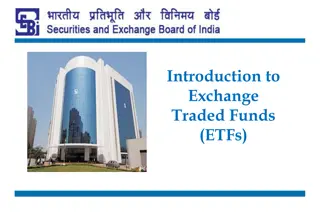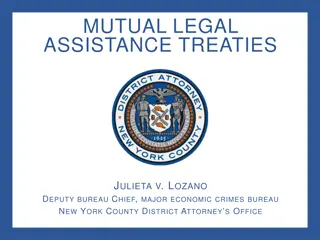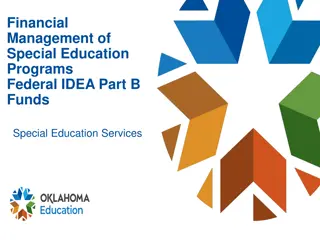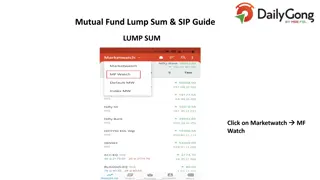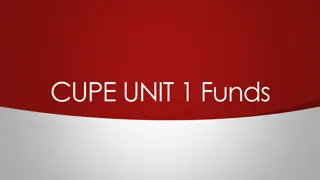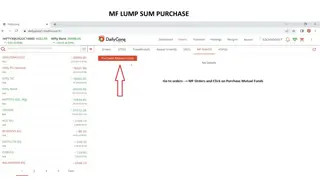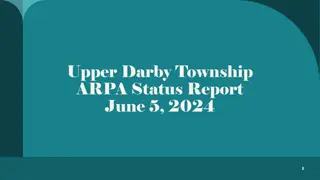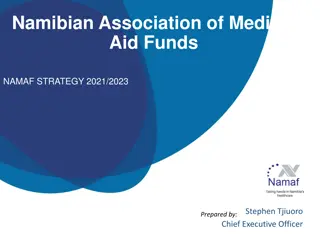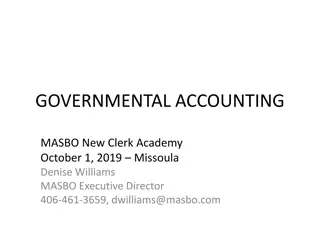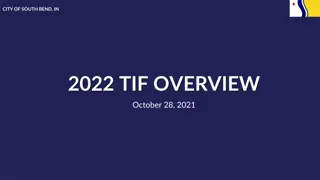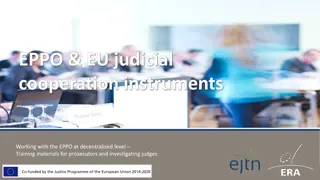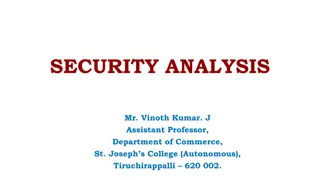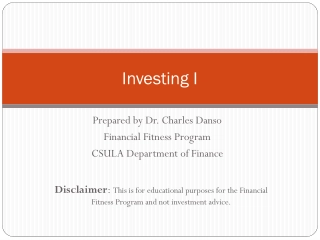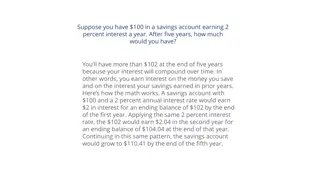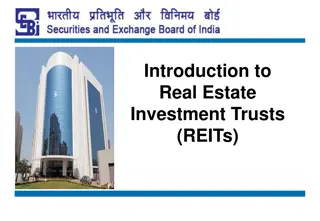Understanding Mutual Funds: A Comprehensive Guide
This presentation provides an educational overview of mutual funds, covering topics such as what mutual funds are, how to invest in them, the structure of mutual funds, the role of Asset Management Companies (AMCs), and how mutual funds work. It also explores the classification of mutual funds, investment options, risk management, and more. The aim is to enhance knowledge and awareness for investors in the securities market.
Download Presentation

Please find below an Image/Link to download the presentation.
The content on the website is provided AS IS for your information and personal use only. It may not be sold, licensed, or shared on other websites without obtaining consent from the author. Download presentation by click this link. If you encounter any issues during the download, it is possible that the publisher has removed the file from their server.
E N D
Presentation Transcript
Introduction to Mutual Funds
Disclaimer Disclaimer Information contained in this presentation is as on September 30, 2022. The information contained in this presentation is only for Educational and Awareness Purposes related to securities market . This presentation is only for Educational and Investor Awareness Programs and shall not be used for any legal interpretations. SEBI or Stock Exchanges or Depositories shall not be responsible for any damage or loss to any one of any manner from use of this material. Suggestions or feedbacks, if any, may please be sent by mail to visitsebi@sebi.gov.in. 2
Flow of Presentation What is a Mutual Fund ? How to invest in Mutual Funds? Structure of Mutual Fund Centralized KYC What is an Asset Management Company (AMC)? Mutual Fund investment procedure Investment Modes in Mutual Funds How does a Mutual Fund Work? Mutual Funds Classification of Mutual Funds Plans Growth vs Dividend Options Based on Structure How to check information about the Mutual Funds (Offer Document)? Based on Investment Objective Investment Portfolio Risk-o-Meter Risk vs Return Mutual fund investment on behalf of minor and nomination details Categorization of Mutual Funds 3
What is a Mutual Fund (MF)? Common pool of funds contributed by investors and invested in accordance to the objectives. Investments are held in a trust of which the investors alone are the joint beneficial owners. Trustees oversee the management by investment manager. 4
What is an Asset Management Company (AMC)? Investment manager of the mutual fund. Appointed by the trustees, with SEBI approval. Trustees and AMC enter into an investment management agreement. Required to invest seed capital of 1% of amount raised subject to a maximum of Rs.50 lakh in all open-ended schemes. Should have a net worth of at least Rs.50 crore at all times. At least 50% of members of the board of an AMC have to be independent. AMC of one mutual fund cannot be an AMC or trustee of another fund. AMCs cannot engage in any business other than that of financial advisory and investment management 6
How does a Mutual Fund Work? Pool money. Invested according to pre-specified investment objectives. Benefits accrue those that contribute to this pool. There is thus mutuality in the contribution and the benefit. Hence the mutual fund. of investors to name 7
Classification of Mutual Funds Classification of Mutual Funds Based on Investment Objective Based on Investment Style Based on Structure Open Ended Funds Debt Funds Passive Funds Closed Ended Funds Equity Funds Active Funds Hybrid Funds Interval Funds 8
Classification - Based on Structure No fixed maturity date. Accept continuous sale and re-purchase requests. Transactions are NAV-based. Unit capital is not fixed. Open Ended Funds Closed Ended Funds Run for a specific period. Offered in an NFO but are closed for further purchases after NFO. Unit capital is kept constant. Interval Funds Variant of closed-ended funds. Becomes open-ended at specific intervals. Have to be mandatorily listed. 9
Classification - Based on Investment Objective Debt Funds Invest in short and long term debt instruments. Aim to provide regular income. Equity Funds Invest in equity securities. Aim to provide growth and capital appreciation over long term. Hybrid Funds Invest in a combination of equity and debt securities. Proportion of equity and debt may vary. Aim to provide for appreciation. both income and capital 10
Classification - Based on Investment Style Passive Funds Replicate a market index. Invest in same securities and in same proportion as that of index. No active selection of any stock / sector. Expenses are lower. Portfolio is modified every time index composition changes. Active Funds Invests in securities and sectors that may offer a better return than the index. Actively manage the allocation to market securities and cash. May perform better or worse than the market index. Incur a higher cost than passive funds. 11
Categorization of Mutual Fund Schemes Categorization of open-end mutual funds: - To ensure uniformity in characteristics of similar type of schemes launched by different mutual funds. - Helps investors to evaluate different options available before making informed decision to invest. Hybrid Schemes Debt Schemes Solution oriented Schemes Categorization of Mutual Fund Schemes Equity Schemes Other Schemes 12
How to invest in Mutual Funds? Via Physical Mutual Fund Application Form Via Online Mode (Website of Mutual Fund) Via AMFI Registered Mutual Fund Distributor (using physical form/ online/ mobile app) Via Mobile App of Mutual Fund 13
Centralized KYC (C-KYC) in Securities Market KYC registration is centralized through KYC Registration Agencies (KRAs) registered with SEBI. Each investor to undergo KYC process only once in securities market and details would be shared with other intermediaries by the KRAs. Standard Account Opening form (AOF) has 2 parts: - Part I : Basic and uniform KYC details of the investor - Part II : Additional KYC information as may be sought separately by the Mutual Fund 14
Mutual Funds investment procedure Indicate whether you are a First Time Investor/ Existing Investor. Visit official website of KRA and check whether you are KYC compliant or not. You must submit this KYC status. Provide your details like name, address, etc. Submit Bank account details and copy of Cancelled Cheque . Once documents are accepted by Mutual Fund Company, you may start making investment. 15
Investment Modes in Mutual Funds Lump-sum Investment One time investment. Usually, large sum of money is invested in one go. Investor faces risk of volatility in markets. Systematic Investment Plan (SIP) Staggered Investment. Period of commitment - 6 months, 1 / 3 / 5 years. Specific intervals - monthly, quarterly, half-yearly. Made on specific dates e.g. 1st, 5th, 10th, 15th of every month. 16
Investment Modes in Mutual Funds Direct Mutual Fund Regular Mutual Fund Directly offered by fund house. No involvement of third party agents distributors. No commissions brokerage. Have low (because of no commissions). Have high NAV. Return is higher due to a lower expense ratio Bought intermediary. Intermediaries can be brokers, advisors or distributors. Commissions and brokerage paid. High Expense ratio as there are commissions to pay. Low NAV. Return is lower due to a higher expense ratio through an brokers or and Expense ratio 17
Mutual Fund Plans Growth vs Dividend Options Gains made in portfolio are retained and reflected in NAV. Realized profit/loss is treated as capital gains or loss. No increase or decrease in number of units, except if units are purchased or sold, by the investor. Growth Option Fund declares dividend from realized profits. Amount and frequency varies and depends upon distributable surplus. NAV falls after dividend payout to the extent of dividend paid. Dividend Payout Option Dividend is re-invested in same scheme by buying additional units at ex-dividend NAV. Number of units standing to the credit of the investor, increases each time a dividend is declared, and reinvested back into the scheme. Dividend Reinvestment Option 18
How to check information about the Mutual Funds (Offer Document)? Statement of additional information (SAI) Contains generic and statutory information of mutual fund. Contains financial information of mutual fund. Lays down rights of investor. Other additional information. Scheme type (open or closed end). Investment objective. Asset allocation. Investment strategies. Terms with regard to liquidity. Fees and expenses. Other information relating to the scheme. Scheme information document (SID) 19
Risk-o-Meter and its importance Six levels of risk for mutual fund schemes: Importance of Risk-o-meter : - Helps align risk that a fund carries with the risk profile of the investor. i. Low Risk ii. Low to Moderate Risk iii. Moderate Risk iv. Moderately High Risk v. High Risk and vi. Very High Risk - - - Equity as asset class: Volatile: High risk Debt as asset class: Stable: Low risk Hybrid: Moderate: allocation and concentration Depends on 20
Nomination for Trading/Demat/Mutual Fund Units Investor to get two options regarding nomination To provide nomination in the prescribed form up to three person along with their percentage Opting out of nomination through prescribed declaration form Folios/Account to be freezed if none is opted till March 31, 2023 Applicable for opening new Demat account and trading accounts on or after October 01, 2021 Applicable for investor subscribing to mutual fund units on or after October 01, 2022. For existing unit holder, AMC shall provide an option to submit In case of physical option, the form shall carry the wet signature In case of online option, AMC shall validate the form using e-Sign Or through two factor authentication (2FA) 21
Mutual Fund investment by Minor Payment on behalf of minor shall be from Bank Account of the minor Joint account of the minor with the guardian KYC process to be completed upon attaining the status of major 22
23 Additional Information Additional Information For further information, you may visit the following web-sites and Mobile App: www.sebi.gov.in/ https://investor.sebi.gov.in/ Saa Saa thi thi App App For Grievance Redressal, you may visit following website: www.scores.gov.in/ Or, you may call SEBI at following Toll-free Helpline Numbers from 9:00am to 6:00pm on all days (excluding declared holidays in the state of Maharashtra): 1800 266 7575 1800 22 7575 SEBI : HAR INVESTOR KI TAAQAT Helplines are available in 8 Languages: English, Hindi, Bengali, Gujarati, Marathi, Kannada, Telugu and Tamil 23
Thank You 24










